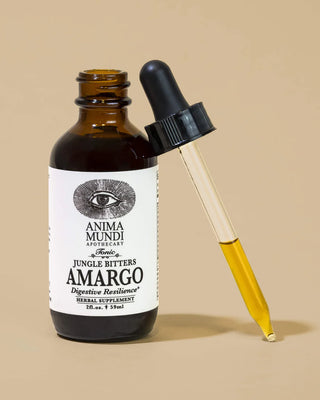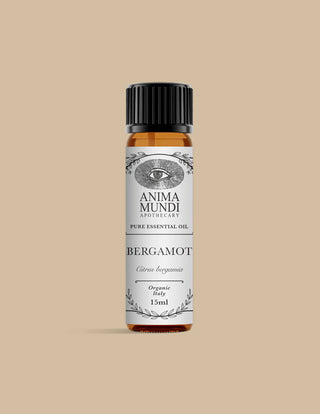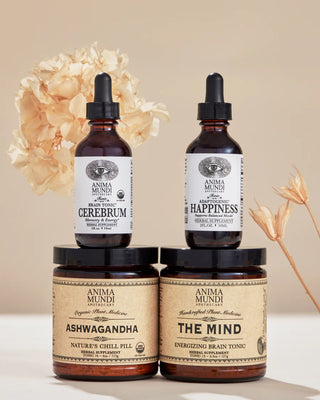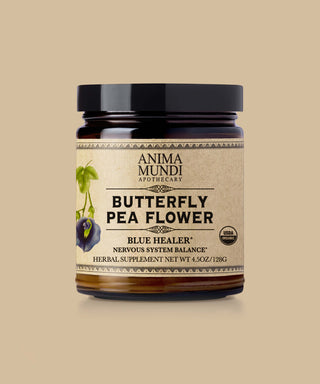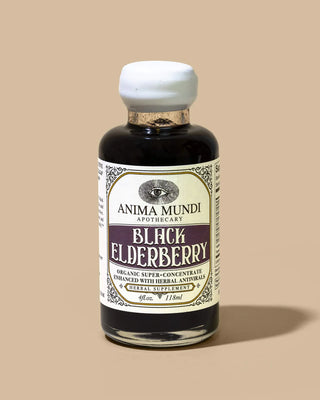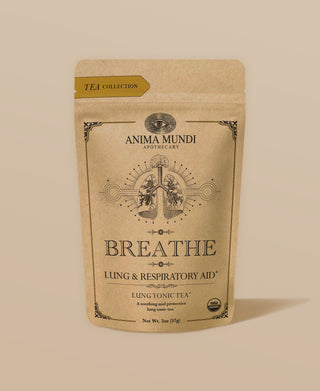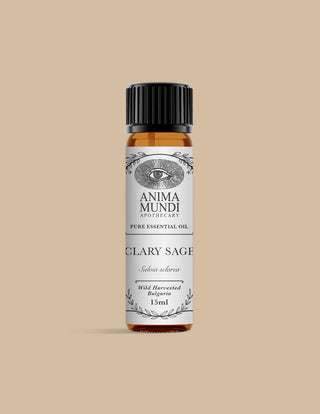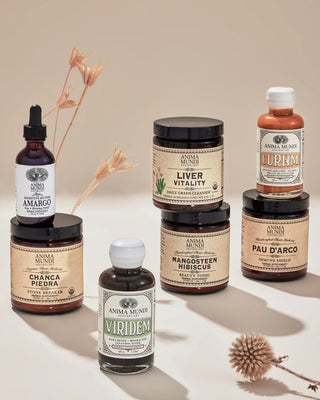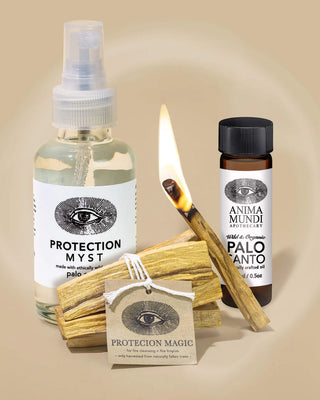All product imagery and descriptions have been graciously provided by Anima Mundi and are displayed for demonstration purposes only. You can buy their products on their online store.
If you think protein supplements are only for fitness fanatics and bodybuilders, you might be shocked to know that many nutritionists, herbalists, and medical professionals also recommend these essential macronutrient powders for their many benefits outside of gym culture.
Protein is essential because it enables the body to repair tissues, produces critical enzymes and hormones, and helps to build muscle, among other functions. For many of us, preparing or consuming three balanced meals every day can be challenging at times. Protein powders can help us reach our health goals in a nutritious and often affordable way.
Your daily diet may not provide sufficient protein, or you may have goals for physical recovery and repair that upping your protein intake could support. Whatever your reasons for being protein-curious, we’re here to help you decide which type of powder is best for you, which to avoid, and how to navigate the heavily coded labels that dominate the market today.
Who Uses Protein Powders + Why
Scientific studies have confirmed that consuming protein powder can assist with building muscles, post-workout recovery and weight loss, among other benefits. Despite popular myths about who should use dietary supplements, anyone who wants to add more protein to their diet can use protein powders, as they are widely available in stores and online. It’s easy to mix with liquids like water or milk, soups and smoothies, and it can be added to other home-cooked meals.
Researchers have found that some people who eat a mostly (or strictly) plant-based diet may struggle to meet their protein requirements through diet alone if they are not regularly consuming protein-rich foods. Health and genetic conditions ranging from eating disorders to IBS and cancer may also lead to protein deficiency. While this is rarer in the United States, there are many countries where lack of protein is common and has serious consequences, especially in early childhood development. Protein deficiency can lead to malnutrition or other life threatening outcomes.
A reduced appetite from cancer treatment or older age, a wound that is slow to heal, or a serious burn are some other reasons people use protein powders to help the body get extra calories and protein that can repair and replace cells, among other critical functions of healthy protein intake. Of course, the more common users are those with specific fitness goals. Whether trying to bulk up in muscle mass or get leaner, those who exercise regularly often include protein powders and other dietary supplements as part of their personal fitness plans to achieve their desired outcomes.
Main Types of Protein Powders
In order to create protein powders, protein is condensed from either animal sources (eggs, milk, etc.) or plant-based sources (peas, rice, soybeans, etc.). But, many highly processed powders may also contain artificial flavors, hidden fillers or additives like dextrin, sugar, glucose or xanthan gum. We recommend you steer clear of these unhealthy options! Whether derived from plant or animal sources, the four main types of protein powders are:
- WHEY PROTEIN - the most commonly available powder on the market today. Originates from milk and is a direct by-product of the cheese making process.
- CASEIN PROTEIN - releases protein slowly, so is said to be beneficial to muscle recovery. Also originates from milk.
- EGG PROTEIN - known for their high protein content, egg whites (sans yolks) are generally the primary ingredient in these protein powders.
- PLANT PROTEIN - free of the cholesterol found in whey and casein protein powders, plant protein powders are unsaturated and were found equally effective for strength and performance to their animal protein counterparts in a side-by-side comparison.
Check The Label: Less is Best
We’ll keep it simple. Here’s our label vs a generic label:

We’re looking for protein powders that contain few ingredients, are ideally made from real whole foods, are unsweetened, list protein as the first ingredient, and don’t have yucky or weird stuff (see below for more on the shocking things found in some protein powders - eek!) included in the recipe. But, given many health fitness gurus suggest “hacking” or “decoding” the labels, there’s clearly some misleading going on by a lot of protein powder manufacturers. Beware of false advertising.
6 Things To Know Before Buying
Asking the right questions is fundamental. What’s in so many of these products is often not derived from natural sources, and can be downright toxic for your health. In one study, researchers found over half of the 134 products they tested from 52 brands contained high levels of pesticides, heavy metals, and other carcinogenic and infertility-causing toxins. That’s scary to even think about, let alone to consider consuming!
When seeking the highest quality protein powder, ask these five questions first:
- Does it have any weird fillers or additives? Often “spiked” with empty fillers, many commercial protein powders use extra ingredients that are known to cause gastric distress and digestive issues.
Are GMOs (Genetically Modified Organisms) part of the package? Beyond the full scope of how GMOs affect human health (research remains scarce while public skepticism is still very high), there are real biological, ecological and economic concerns we should all be concerned about as beings who eat to stay alive! Instead, look for GMO-free products.
- What “natural flavors” are in this product, and what does that even mean? “There seem to be about 1,000 chemicals in the GRAS category that have not been researched or approved by the FDA or anyone else,” Nourish Schools co-founder Casey Seidenberg wrote in The Washington Post. GRAS = Generally Regarded As Safe, but Seidenberg and others rightly question whether “unstudied natural flavors” can be considered safe or healthy.

Is there any real chocolate (or other flavor in the name/description) in the recipe? As a general rule of thumb, if you don’t recognize multiple ingredient names, there’s probably not any “real” food (i.e. not artificially made) in it. The American Council on Science and Health does a great job detailing the exploitation of customers by the “natural fallacy”.
Does this product contain heavy metals or chemicals? Shocking truth: arsenic, cadmium, mercury and lead were found in 15+ processed protein powders in a lab test by Consumer Reports.
- Does it have sweeteners? Most powders have either synthetic sweeteners or lots of sugary stuff of sorts. Be sure to keep a KEEN eye if you’re looking for zero sugar, which is what we recommend.
Check out the ingredients!
Pea Protein*, Pumpkin Seed Protein, Sacha Inchi Protein, Silk Brown Rice Protein*, Cacao Bean*, Carob*, Baobab*, Maca Root*, Cordyceps Mushroom*, Cinnamon Bark*, Suma Root*, Yacon Root
All ingredients with a * are 100% Certified Organic. How many of these do you recognize? Notice there are no weird fillers or other additives? Here’s a bit more about the ingredients that may be unfamiliar to you, and how they support sustainable energy, recovery, stress reduction, and more:
- Sacha Inchi is an Amazonian “super seed” and source of fiber that has been used for centuries in indigenous communities, with 95% of the world’s production concentrated in Peru. Research suggests it may support healthy cholesterol levels, gut and heart health, and improved blood pressure and weight loss.
- Carob has long been celebrated for its high fiber and mineral content, as well as its low fat levels. The fruit of an evergreen tree cultivated in the Mediterranean region, carob is rich in fatty acids, carbohydrates, fiber, and amino acids.
- Baobab is a tree that grows in parts of Africa, the Middle East, and Australia whose wild-harvested fruit and powder contains high levels of vitamin C, potassium and carbohydrates, and may support a vast array of medicinal benefits. Many traditions consider its leaves, bark and seeds capable of treating almost any disease, improving digestive and skin health, and supporting the immune system.
- Maca has been used as a medicinal food for centuries by the people of the high altitude Andes regions of Peru and Bolivia. As an adaptogen, it supports overall wellbeing and a healthy mood. According to folk beliefs, maca is also an aphrodisiac and energy booster with the potential to increase exercise performance and more.
- Cordyceps have been considered an energizing “heal all” in Traditional Chinese Medicine for hundreds of years. Its main supportive actions include boosting mental and physical strength, improving energy, endurance and stamina, and enhancing libido. Our beloved mushrooms are grown in a small farm, 100% organically and sustainably, in Washington State. They are cell wall extracted for optimized bioavailability, and contain both fruiting bodies and mycelium.
- Suma is also known as para toda (“for all things”) throughout South America and Brazilian ginseng in much of the rest of the world. Cardio supportive and libido boosting, the indigenous peoples of the Amazon region have used the root for generations for a variety of health purposes, including energy and stimulation, and to support athletic performance and recovery, while also protecting against the potential side effects of stress.
- Yacon is a common part of South American diets that looks like a sweet potato and is said to taste similar to a pear. Often referred to as the “diet potato”, research has demonstrated its potential benefits for gut and bone health, as a mild appetite suppressant, and its many biological properties that support healthy blood sugar and cholesterol levels, insulin, and mineral absorption, among others.
Its benefits extend far beyond the gym.
Designed using a blend of mostly South American roots and seeds, our Chocolate Protein Superfood Powder is unlike any other plant-based protein powder. The ingredients have been traditionally used for energy, strength, stamina, and resilience in and beyond the Amazon region. This blend is high in both fiber and protein (15g per serving), which makes it an exceptional ally for pre- and post-workout nutrition. Adaptogens and superfoods like cacao, maca and cordyceps help to support the adrenals and encourage stamina. Best of all, our prebiotic rich, plant-based powder is a great source for sustainable energy and recovery that may help regulate blood sugar, treat adrenal fatigue, and reduce the overall toll that excessive stress takes on the body.
It’s got nothing but the good stuff.
NO weird fillers. NO GMOs. NO “natural flavors”. ABSOLUTELY NO heavy metals or other toxins. YES, real chocolate. YES organic ingredients that are easy to read and clearly labeled. YES, it is made from 100% plant-based proteins.
Last but not least!
For those of you concerned with legumes and grains, we’ve included our Certificates of Analysis (COA’s) for both of these since these are major concerns on the sourcing of these types of foods. We specifically focused on sourcing it from farms that didn’t have any issue with transparently sharing the chemical analysis on both of these, since they indeed can be dirty if not well-souced. Like many of the foods that many of us love! We purposefully included them within our formula so the amount of plant protein per serving is as high as possible. Rest assured, find them here.
CHOCOLATE PROTEIN SMOOTHIE BOWL RECIPE
A delicious and nourishing bowl that can be tweaked as desired. We're using a mix of avocado, coconut and banana as a base, but you can use entirely avocado and coconut for a lower glycemic smoothie bowl. Our Chocolate Protein contains zero sugar (none of the fake sugars either), and the great news is that it tastes SO GOOD. We can't wait to hear what you think. Try this lovely breakfast or healthy dessert bowl when in the mood for some chocolatey goodness.
INGREDIENTS:
- 6 ounces coconut water or filtered water
- 6 ounces of plant-based milk (coconut milk is our fave)
- 1 frozen ripe banana
- ½ avocado (or 1 whole avo if you opt out banana)
- ½ cup blueberries (or berries of choice)
- ¼ cup ice
- 1 serving of Chocolate Protein Powder (4 Tbsp)
DIRECTIONS:
Place all ingredients in a blender for about 20-30seconds (or until creamy). If you’d like it thicker to make it a smoothie bowl, lower about 4ounces of liquid, or increase avocado or banana to make it thicker. Pour into a bowl or favorite glass. Top with granola, more blueberries, or fruit of choice if desired. Enjoy!

